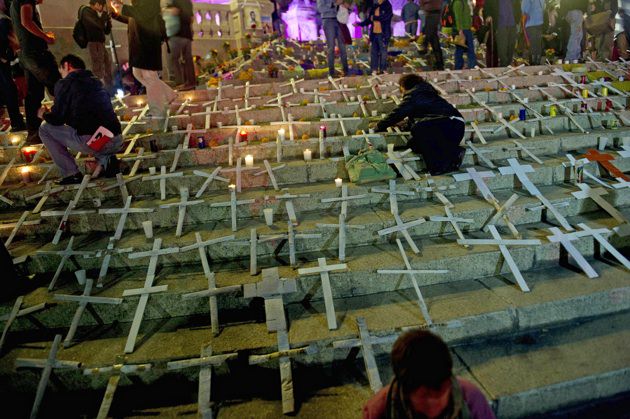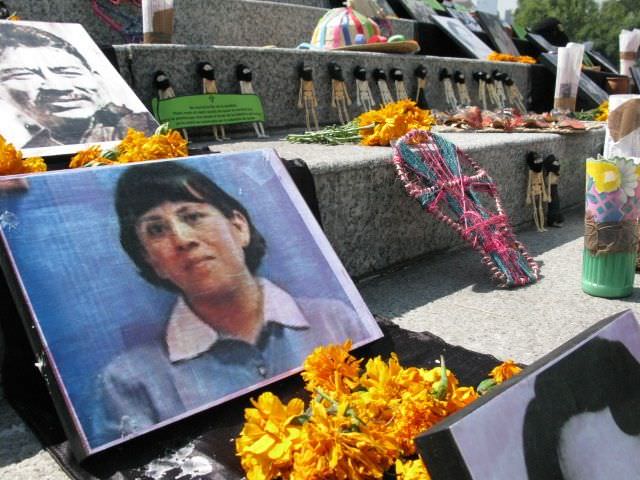In Mexico, the dearly beloved who are no longer in this world receive special dispensation to return to us once a year. To celebrate this miracle, we bring flowers to an elaborate, colorful altar, make a path with marigold petals to show them the way, sing to them, pamper them with offerings of their favorite foods, and generally laugh with them at death and other things. In certain parts of the country, the Day of the Dead, and the altar-building events that lead up to it, are a bigger deal than Christmas.
This November 2nd has turned out slightly different from the preceding ones, however. For one, the encroaching influence of Halloween in the major cities is starting to give the Day of the Dead a slightly ghoulish cast; furthermore, as the number of fatalities in the current wave of narcowar violence approaches 40,000, a growing number of people have decided that these dead, too, should be remembered, although their killing is hardly a cause for celebration.
So it was that on Monday night a neatly dressed young man with formal manners and a pleasant face stood sobbing, a candle in his hand, at the foot of Mexico City’s Angel de la Independencia, which floats gracefully above a tall column on the Paseo de la Reforma. Around him dozens of people were adding their own candles to the thousands already on the monument steps, which were glowing wonderfully in the chill night. The young man’s name was Diego Enrique Hernández, and struggling to compose himself, he said that although he had not himself lost any family members or even friends in the current violence, he was horrified—and ashamed—to see what had become of his beautiful home state of Veracruz. That was why, he said, he had joined one of the numerous peace movements that have sprung up in the last two or three years and come to leave a candle on the steps.
“The victims they found the other day”—he was referring to a late September incident, in which 35 decapitated corpses were dumped out of two trucks onto a freeway in broad daylight in the city of Veracruz—“were right near a shopping center I used to go to as a child,” Hernández said. “And I don’t think it’s right that people can’t leave their houses for fear, and that I call my friends and they tell me they just heard bullets nearby.” Like many people at the event, he blamed President Felipe Calderón directly for the current horrors. “Ever since that gentleman—I don’t consider him my president—declared this thing that can hardly be called a war, because supposedly when you have a war you have a plan…ever since then, we have seen these things happening.”
Not far away, a tall grey-haired man with deep-set eyes stood chatting with his elegantly-dressed friends. I asked him why he had come to the altar. “Because I believe in what these people are doing, first of all,” he said. “And because my godson was murdered in Cuernavaca.” As it turned out, his godson was Juan Francisco Sicilia, son of the poet and essayist Javier Sicilia, who created the [Movement for Peace with Justice and Dignity] (http://movimientoporlapaz.mx/) last April, following the murder of Juan Francisco and four other young men, possibly at the hands of police associated with a local mafia. “Juan Francisco’s death made me aware of how terrible the situation is that we are living through,” Jorge González de Leon said.
Grassroots movements against state-sponsored violence, or violence the state has been powerless to stop, really began some ten years ago, at a time when women were being murdered at a scandalously high rate in Ciudad Juárez, which lies just across the border from El Paso, Texas. The murders, often involving mutilation of the victims, were horrifying enough, but what galvanized many women, particularly, into action was the evident pleasure local and federal police took in humiliating the victims’ families and obstructing the investigations—almost, it would seem, as if they were actually in league with the murderers.
The drug-trafficking organizations currently at war with the government and each other have terrorized the country by staging a careful campaign based on grand-guignol displays of violence—civilians are persecuted for alerting the police or attempting to organize resistance movements, for example, and corpses are always displayed with horrific mutilations. This is powerful dissuasion, along with the fact that, by Felipe Calderón’s own admission, most of the various police corps are corrupt—and increasingly involved in the bloodshed, to judge from the numbers of police and military personnel arrested and accused of murder. Consequently, the growth of the anti-drug violence movement has been slow.
Advertisement
But the murder of Javier Sicilia’s son galvanized first a family, then a city, and then the increasingly large community of victims’ relatives. Because Sicilia has a column in the most-read weekly magazine here, and is a well-known poet, and because the government’s contention that the victims of violence are themselves involved in the narco war so clearly flew in the face of the murder of Sicilia’s son, he has been able to mobilize the press in his favor too. Walking from Cuernavaca to Mexico City, and then travelling north by bus from city to city, staging small rallies at which victims’ relatives have stepped forth with increasing confidence to denounce the crimes committed against them, the Caravan for Peace he organized emerged almost overnight as the moving center of a growing protest movement.
Sicilia, who sees Gandhi as one of his principal inspirations, has struggled to stay clear of political parties who would love nothing more than to adopt him. Having seen their efforts grow from a Caravana por la Paz to a Movimiento por la Paz con Justicia y Dignidad, the activists are now engaged in a broad, if slightly unfocused, range of activities. Some are looking for ways to name and, if possible, provide a photograph and history of each one of the victims (the movement counts the total number of dead in the last six years as 50,000, not including 10,000 disappeared.) There are also broad calls for social justice as an antidote to violence, but what has generated most support is the demand for an end to arbitrary arrests, disappearances, and the official use of torture, and, in general, an end to the use of violence by government forces as a means to combat the drug trade.
Fraught though it is with the divisions and mutual accusations grass-roots organizations are often plagued by, the movement has managed to survive and grow in numbers over the last five months, and most of all in visibility, even if it remains a largely middle-class concern. It was the sponsoring organization of Monday’s altar.
“I think it’s important that everyone here is participating,” said González de Leon, Juan Francisco Sicilia’s godfather. “I wish there were more of us, but even if there were only one, it would count.”




